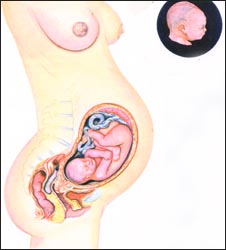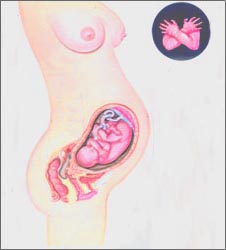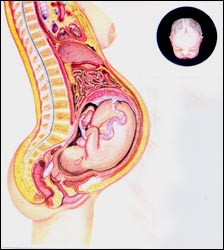


Fetus growth and development during the third trimester of pregnancy 임신 제3 삼개월기 태아의 성장 발육
- The gestation period from the beginning of 7 months to the end of 9 months of pregnancy is called the third trimester of pregnancy (third trimester / third trimester of pregnancy) for convenience in obstetrics.
- During the third trimester of the last pregnancy, the fetus continues to grow and develop and is born at term. It is a uterus containing a growing fetus, and the stomach is uncomfortable and constipation can occur due to pressure on the organs in the abdominal cavity of the pregnant woman and the gastrointestinal tract, especially in the pelvis.
- The diaphragm is pushed more into the thoracic cavity than in the second trimester of pregnancy, making breathing more difficult and pressing the bladder can make it difficult to urinate.
- The fetus plays more often than before. It is good to prepare the necessary things for childbirth, childbirth, postpartum care, and baby-rearing by at least 7-8 months of pregnancy.
The growth and development of the fetus at 28 weeks

- 7 months pregnant Source-Pregnancy in Anatomical Illustrations, Carnation Healthcare Services, Los Angeles, CA,
- From pregnancy to newborn care. The hair grows more and the hair becomes thicker.
You can open and close your eyes. - The bone marrow is formed and red blood cells that have been formed in the liver are now produced in the bone marrow.
- The bones become more calcified, making them thicker and stronger.
- Brain, eyes, mouth, heart, lungs, liver, stomach, kidneys, etc. grow, develop, mature, and function more. The baby’s head is taken to be born.
- The height of the fetus from the tip of the head to the buttocks is 27cm, and the weight is about 1.36 kg. Growth and development of a 29-week-old fetus The pupil of the eye may become larger when exposed to light, and may become smaller in dark places, and the color of the eye may appear.
- However, the color of the eyes is definitely determined at 6 to 9 months of age.
- From this point on, the growth rate increases compared to before.
- The development of the functions of each organ continues as before.
- The height of the fetus from the tip of the head to the buttocks is 28 cm, and the weight is about 1.59 kg.
The growth and development of the fetus at 30 weeks
- All organs grow slowly, become larger and function more and more active.
- You can turn your face from one side to another.
- Open and close your eyes.
- Research shows that you sleep for 90 to 95% of 24 hours a day.
- After birth, they do a lot of breathing exercises with their own strength in order to breathe, which is extremely necessary to maintain basic life.
- The fetus can be kicked with its feet, arms, and legs folded and stretched, stretched, and can be played by moving the torso from side to side.
- You can also see the fetus in the womb kicking the mother’s abdominal wall with a small heel and the stomach skin popping up.
- The height of the fetus from the tip of the head to the buttocks is 29cm and the weight is about 1.8 kg.
The growth and development of the fetus at 31 weeks

- 8 months pregnant Source-Pregnancy in Anatomical Illustrations, Carnation Healthcare Servicses, Los Angeles, CA, From Pregnancy to Newborn Care (Hearing Gak)
- The fat layer under the skin becomes thicker, the central nervous system is more developed, and its function becomes more active.
- Because the entire space in the womb is cramped compared to the size of the baby, it is not possible to do exercises such as acrobats, and it is mainly used for baby exercises such as kicking and moving the body little by little.
- The closer you are to the due date of birth, the more mature fetuses will not be able to conceive in the womb if they can sit, lie down, stand, kick and punch like their predecessors in the womb. As the fetus grows more and more mature and larger, the fetus is restricted from moving and exercising in the womb at will. It is really fascinating when you think about this harmony of pregnancy.
- Almost every exercise that a pregnant woman takes-sitting, standing, eating, sleeping, or crawling-can also change the baby’s movement.
- Obstetrics sometimes check the degree of movement of the baby as needed.
- For example, by doing this test, you can get information such as 5 or 10 movements per hour.
- Even at this time, pregnant women should take a break both mentally and physically.
- Heavy things should be avoided as long as they can be difficult mentally and physically, neither dragging nor lifting.
- The height of the fetus from the tip of the head to the buttocks is 30cm and the weight is about 2kg.
The growth and development of a 32-week-old fetus
- The fetus’s head faces the birth canal and poses for birth. In 3-4% of the fetuses, the hips or legs are advanced toward the birth canal instead of the head advanced to the birth canal.
- If the fetus’s buttocks or legs are in an advanced position in the birth canal, the obstetrics may change the advanced position of the fetus as necessary to make the head advanced to the birth canal.
- The immune system is formed.
- At this time, the height of the fetus from the tip of the head to the buttocks is 32cm and the weight is about 2.5kg.
Growth and development of a 33-week-old fetus
- Today, obstetrics and neonatal science have developed remarkably.
- There are special specialists who can take special care of the health of the fetus before birth and specialize in researching and studying the medicine of the fetus. Such a specialist is called a perinatologist.
- There are also special pediatricians specializing in the health and disease of newborns.
- There is also a neonatal intensive care unit that specializes in the health and illness of newborns, and a neonatal intensive care team consisting of nurses specializing in nursing care for newborns and medical personnel accordingly.
- Medical technology that treats newborns when they are sick or born as premature or overmature babies has been remarkably advanced.
- With these benefits, if babies born at 33 weeks are intensively and properly treated and nurtured, the survival rate is 99%.
- The height of the fetus from the tip of the head to the buttocks is 33cm and the weight is about 2.5kg.
Growth and development of a 34-week-old fetus
- You may notice that the baby’s telegram moves less, but is stronger each time he moves. The baby continues to be ready for birth.
- The head, one of which is the advanced woman of the fetus, descends toward the birth canal and toward the pelvic floor.
- As it gets closer to the expected date of birth, it takes a posture to move forward gradually toward Sando.
- The height of the fetus from the tip of the head to the buttocks is 34cm and the weight is about 2.7kg.
Growth and development of a 35-week-old fetus
- A fetus at 35 weeks is a fetus at 37 weeks gestation.
- The 35-week-old fetus can be considered a term fetus.
- When you are born, you can grow and develop healthy and well.
- According to research, in order for the fetus in the uterus to be born, a kind of biochemical, or hormone, is sent to the uterus, cervix, etc., and labor begins and delivery is performed.
- The height of the fetus from the tip of the head to the buttocks is 35cm and the weight is about 2.9kg.
The growth and development of a 36-week-old fetus
- At this time, the baby matures to a full term, and all organs are fully formed so that the baby can survive after it is born.
- All organs are still immature, but if love and protection are carefully and appropriately done, they have grown and developed in the womb so that they can continue to grow and develop.
- Now you are ready to be born at any time.
- Meconium is contained in the platoon minister.
- The placenta begins to enter a process of decay. At full term, the base of the uterus, which had risen to the uppermost part of the pregnant woman’s abdominal cavity, gradually descends down the abdominal cavity. In this way, the phenomenon that the uterus containing the full-term fetus comes down from the top of the abdominal cavity of the pregnant woman to the lower part of the abdominal cavity is called fetal dropping, or fetal drop (Dropped).
- When the fetus is submerged in this way (fetal lowering), the lower part of the pregnant woman’s abdomen is called and more uncomfortable than before, but it is easier to breathe.
- At this time, since the uterus containing the full-term fetus can press the bladder in the pelvic cavity around the uterus, it may cause frequent urinate or constipation. From this point on, you must do everything you can to ensure that the pregnancy continues to proceed well until the safe delivery of the full-term baby.
- However, once delivery begins, there is no need to prevent delivery. Preparation for childbirth (childbirth) and postpartum care must be done.
- They are also prepared to take good care of their newborn baby. The height of the fetus from the tip of the head to the buttocks is 35cm and the weight is about 3.1kg.
Growth and development of a 37-week-old fetus
- Now you can survive well even if you are born. A lot of downy is gone, and meconium is contained in the platoon minister.
- labia minor and labia major are enlarged under the influence of hormones, and the clitoris is also significantly larger.
- Due to the influence of female hormones, both boys’ breasts and girls’ breasts may be enlarged, and sometimes even small amounts of milk may be produced.
- Yawning reflections, Moro reflections that can be pinched, rooting reflections that can suck the nipples in the mouth when they touch the face, sucker reflections that can suck the nipples, and things that don’t want to eat or can’t eat.
- There are primitive nerve reflexes such as vomiting reflexes that can be passed when entering the mouth.
- When dust or the like is sucked into the nostrils and enters the nasal cavity, sneeze-based sand is formed that can push the dust out of the airways. It is born with almost 70 kinds of natural physiological reflexes.
- It is impossible to express everything in words. After birth, the baby is taking care of all the preparations to grow and develop after receiving parental protection and unconditional true love.
- At full term, the base of the uterus, which has risen to the top of the pregnant woman’s abdominal cavity, gradually descends to the lower part of the abdominal cavity.
- As explained before, the phenomenon in which the uterus containing the full-term fetus descends from the upper part of the pregnant woman’s abdominal cavity to the lower part of the abdominal cavity is called fetal dropping (胎兒垂下) or fetal descent (Dropped).
- When the fetus is drowned in this way, the belly of the pregnant woman is called and more uncomfortable than before, but it is easier to breathe
- At this time, the uterus containing the full-term fetus presses the bladder of the pregnant woman, so it urinates more often than before.
- From this point on until delivery, you must do your best to keep the pregnancy going well.
- However, once delivery begins, there is no need to prevent delivery.
- And all the preparations for postpartum care for childbirth
- The height of the fetus from the tip of the head to the buttocks is 36cm and the weight is about 3.2kg.

- As soon as the baby is born, he takes his first breath, crying with his mouth open and a loud shout.
- This can be said to be the beginning of a human life. According to research, there are more than 70 neuroreflexes.
- The reflexes grow and develop in harmony in response to stimuli that occur in all organs and tissues in the baby’s body, and all stimuli from outside the baby.
- At full term, the base of the uterus, which has risen to the top of the pregnant woman’s abdominal cavity, goes down little by little.
- As already mentioned, the uterus containing the full-term fetus causes fetal dropping (胎兒垂下), or fetal dropping, from the upper part of the abdominal cavity of the pregnant woman to the lower part of the abdominal cavity.
- When the fetus is drowned in this way, the lower belly of the pregnant woman is called and more uncomfortable than before, but it is easier to breathe.
- At this time, because the uterus containing the full-term fetus presses the bladder of the pregnant woman, urine often dries up.
- From this point on until delivery, you must do your best to keep the pregnancy going well.
- However, once delivery begins, there is no need to prevent delivery.
- And you need to prepare everything for postpartum care for childbirth.
- It is really amazing and amazing to look at the process of pregnancy, childbirth, and childbirth.
- Here, countless things are needed for a baby to grow and develop normally.
- The most necessary of them is true unconditional love from parents.
- Raising your children with that love will make you a really good and productive member of society.
- In the meantime, she was pregnant, she was good at managing her pregnancy health, and she was ready for delivery, and now she has delivered.
- Now, I wish you peace and love for your mother and baby.
- The Pregnancy Bible, Firefly Books
- The Child Is Born, Lennart Nilsson
- 임신에서 신생아 돌보기까지, 이상원
- 부모도 반의사가 되어야 한다. 이상원
- Growth and Development of Children, George H. Lowrey
- Neonatology, Richard Behrman
- Guidelines for PERINATAL CARE, AAP
- The Girlfriends Guide to Pregnancy, Vicki Iovine
- Others
Copyright ⓒ 2014 John Sangwon Lee, MD., FAAP
“부모도 반의사가 되어야 한다”-내용은 여러분들의 의사로부터 얻은 정보와 진료를 대신할 수 없습니다.
“The information contained in this publication should not be used as a substitute for the medical care and advice of your doctor. There may be variations in treatment that your doctor may recommend based on individual facts and circumstances.
“Parental education is the best medicine.“